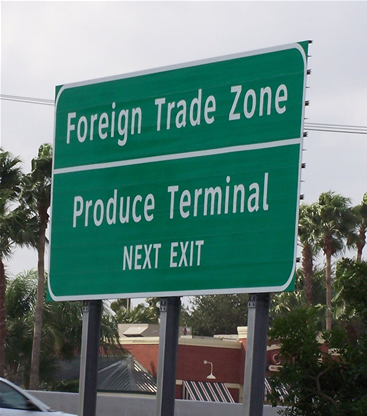Foreign-Trade Zones (FTZ) in the U.S. are faced with twin pressures for change, say industry analysts, who note that new bilateral agreements and ecommerce deals are reconfiguring the global marketplace.
Supply chain managers have long valued FTZs because they are secure areas under U.S. Customs and Border Protection (CBP) supervision generally considered outside CBP territory upon activation. Located in or near CBP ports of entry, they are the United States' version of what are known internationally as free-trade zones.
Currently, there are 276 authorized FTZs across the United States. These zones allow importers and exporters to reduce, eliminate or defer duty payments on manufactured or stored goods prior to releasing them into domestic commerce or exporting them out of the U.S.
Analysts and shippers tell us that the number of beneficiaries is diverse, ranging from the niche ports, inland waterways, and key border crossings.
The Trump Administration's emphasis on restoring U.S. export power threatens to undermine several important trade agreements, say analysts, who add that this may undermine the utility of FTZs. This paradox is not lost on industry leaders.
Erik Autor, president of the National Association of Free Trade Zones (NAFTZ) testified on objectives in the renegotiation of the North American Free Trade Agreement (NAFTA) last June at a hearing before officials of the Office of the U.S. Trade Representative (USTR) and other government agency representatives on the Trade Policy Staff Committee (TPSC).
“The Association has supported NAFTA because the Agreement provides American companies and workers with new opportunities for growth and prosperity, reflect commerce and the economy of the 21st Century, and position the FTZ program to be even more effective in promoting American jobs and competitiveness,” he says.
In his testimony, Autor informed the panel that current provisions in the NAFTA itself and the 1993 U.S. NAFTA implementing legislation have placed U.S.-based FTZ manufacturers at a competitive disadvantage to manufacturing exporting goods from Mexico and Canada. In support of this position, Autor cited NAFTA Article 303 and the Foreign-Trade Zones Act's section on duty deferral along with restrictions in NAFTA rules of origin.
Autor observes that the FTZ program was specifically designed to help U.S.-based manufacturers overcome tariff-inversion situations in cases where duties an American manufacturer must pay on inputs it imports to make a final product in the United States are higher than the duty imposed on an identical final product imported from a foreign country.
“The NAFTZ urges clear direction from Congress that inverted tariffs created by the NAFTA should be addressed through the FTZ program for qualifying goods manufactured in the U.S.,” he adds.
Autor further notes that while some FTZs had pinned hope on restored trade relations with Cuba, the consequences of ongoing tensions has not been profound.
“Looking at the major industries operating in U.S. Foreign-Trade Zones – automobiles, pharma, petroleum, and electronics – and considering the embargo restrictions still in place and the small size of the Cuban market, is unlikely there is much, if any import or export trade with Cuba through FTZs” he says. “While opening Cuba trade could create some opportunities in the future for companies with FTZ operations, the current Administration's roll-back of President Obama's Cuba trade policy will have little or no impact on FTZs.”
SC
MR


Latest Supply Chain News
- Joseph Esteves named CEO of SGS Maine Pointe
- Employees, employers hold divergent views on upskilling the workforce
- April manufacturing output slides after growing in March
- Q1 sees a solid finish with positive U.S.-bound import growth, notes S&P Global Market Intelligence
- World Trade Centers offers a helping hand to create resilient, interconnected supply chains
- More News
Latest Podcast

 Explore
Explore
Business Management News
- Joseph Esteves named CEO of SGS Maine Pointe
- Employees, employers hold divergent views on upskilling the workforce
- April manufacturing output slides after growing in March
- Q1 sees a solid finish with positive U.S.-bound import growth, notes S&P Global Market Intelligence
- 6 Questions With … Sandeep Bhide
- MIT CTL offering humanitarian logistics course
- More Business Management
Latest Business Management Resources

Subscribe

Supply Chain Management Review delivers the best industry content.

Editors’ Picks





